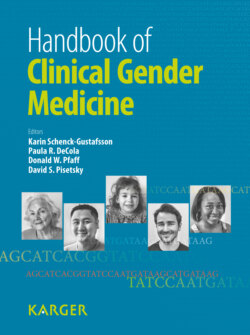Читать книгу Handbook of Clinical Gender Medicine - Группа авторов - Страница 106
Abstract
ОглавлениеOne of the most striking features of autism spectrum conditions (ASC) is that they occur significantly more often in males than in females. Despite this dramatic difference in prevalence, research on potential causes of the biased sex ratio has, until quite recently, been limited. The androgen-exposure model and the X and Y chromosome models offer interesting potential explanations for the biased sex ratio in ASC and require further research attention. While often conceived as competing theories, they may, in fact, be related as there are genes on the X chromosome which are responsive to testosterone and could modulate the production or sensitivity of an individual to testosterone. Given the possibility that ASC are highly polygenic and/or heterogeneous, it is also possible that multiple independent factors contribute to the biased sex ratio. Ultimately, a better understanding of the mechanisms underlying sex differences in the vulnerability to ASC could significantly improve diagnosis, guide research efforts into environmental risk factors, and generate novel, possibly sex-specific, therapeutic possibilities for individuals with ASC.
Copyright © 2012 S. Karger AG, Basel
Autism spectrum conditions (ASC) (referred to as pervasive developmental disorders by the Diagnostic and Statistical Manual of Mental Disorders [1]) constitute a diverse group of neurodevelopmental conditions including classic autism, Asperger syndrome (AS), and childhood disintegrative disorder. While individual children with ASC may differ markedly in phenotype, the conditions share three major domains of features: (1) qualitative impairments in social interaction, (2) qualitative impairments in communication, and (3) restricted, repetitive, and stereotyped patterns of behavior, interests, and activities. Impairments in social interaction may include difficulties in the use of nonverbal social behavior, such as eye contact and gestures, failure to develop peer relationships appropriate for the developmental level, and a lack of social or emotional reciprocity. Communication impairments may include delay in the development of spoken language or difficulties in initiating or sustaining a conversation. Restricted behaviors and interests may manifest as an encompassing preoccupation with a particular topic, inflexible adherence to specific routines or rituals, stereotyped and repetitive motor mannerisms (e.g. hand or finger flapping or twisting or complex whole-body movements), unusual sensory behaviors, and/or persistent preoccupation with parts of objects. In all cases, ‘symptom’ onset is in early childhood [1].
